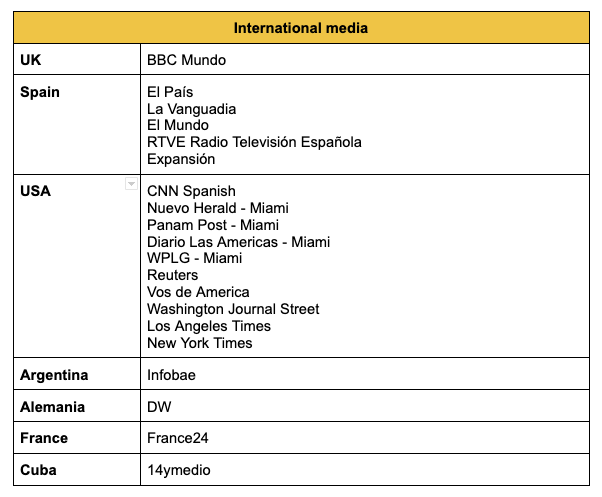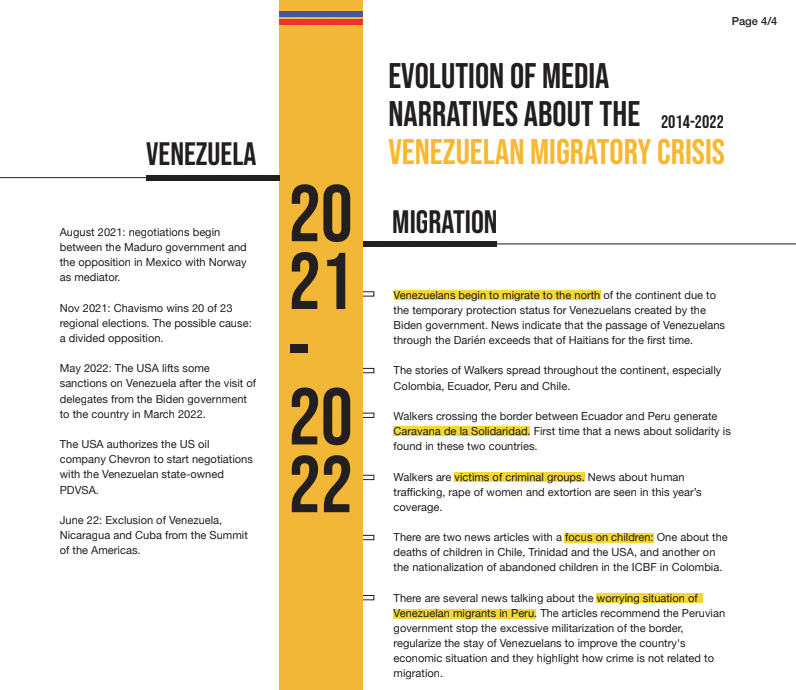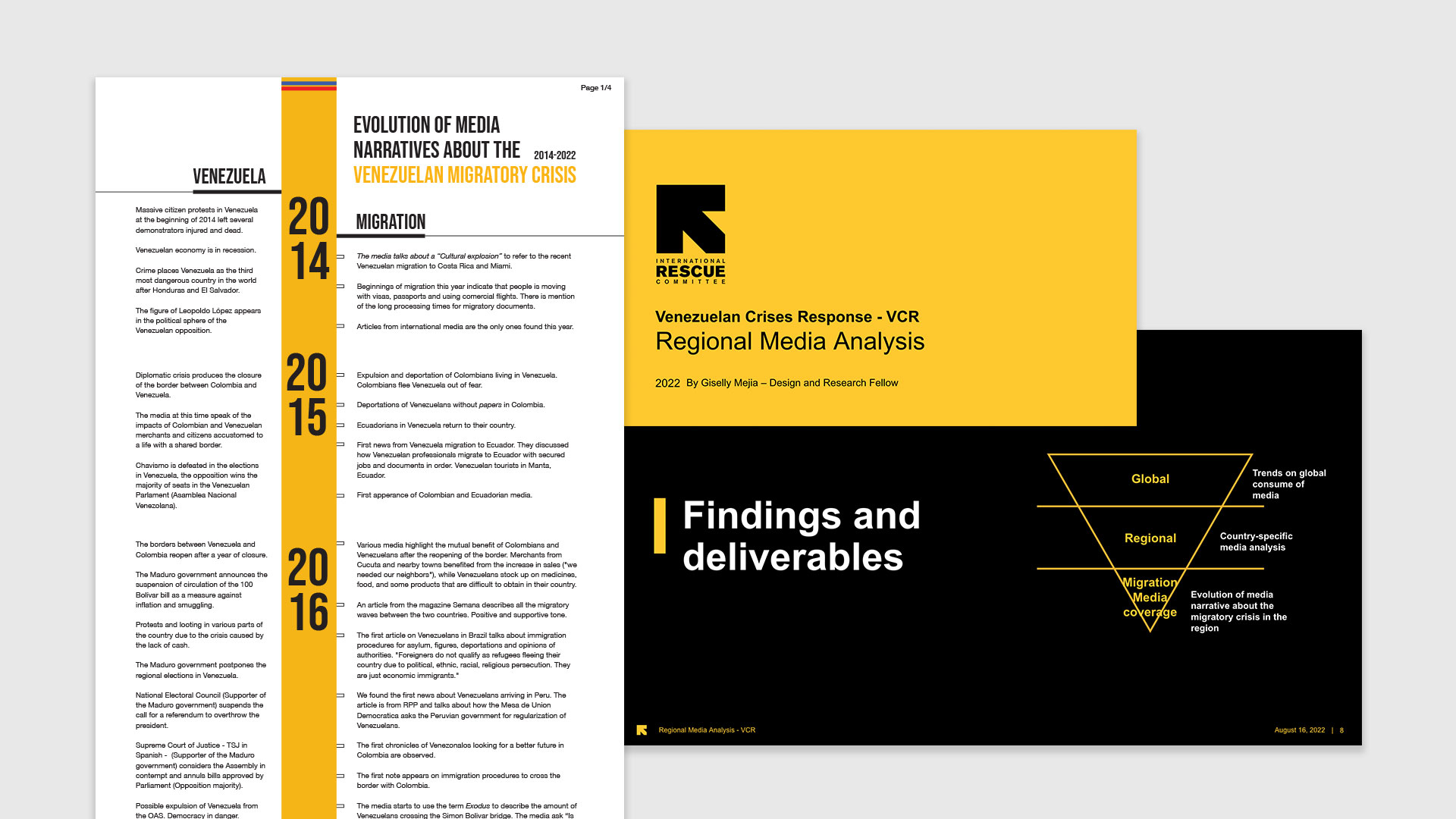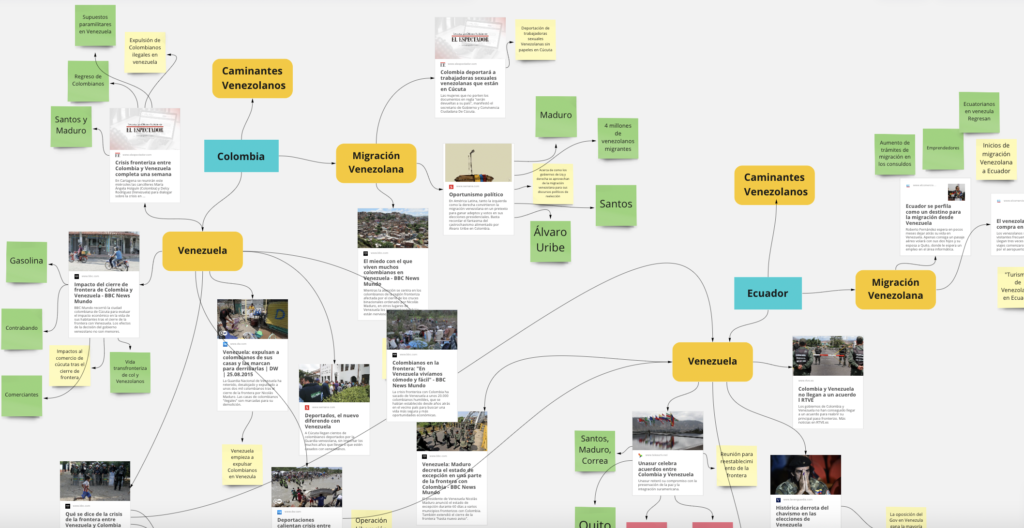Partner: Zolberg Institute and Airbel Impact Lab – Research & Innovation at the IRC.
Timeline: Jun 2022 – August 2022 (3 months)
Approach: applied design research, social innovation, advocacy.
Topics: migration, xenophobia, media narratives.
My role: Design and Research Fellow.
Context
Violence and economic crisis have forced over 4 million Venezuelans to leave the country since 2014. In 2018, the International Rescue Committee – IRC launched an emergency response to this rapidly deteriorating crisis in the city of Cúcuta, Colombia, the principal crossing point for thousands of Venezuelans. Since then, The Venezuela Crisis Response – VCR team has expanded its offering to Venezuelans in different regions and cities in Colombia, Ecuador and Peru.
The VCR’s Communications team was looking to succinctly communicate complex information and data to engage various internal and external audiences. The team was also looking to create a communication strategy addressing the region’s xenophobia sentiments.
Outcomes
My work as a design and research fellow for the Venezuelan Crises Response Team at IRC sit at the nexus of research, advocacy and design. Through a series of interviews, discovery workshops, literature review, and and in-depth investigation on media consumption trends, regional media narratives and programs trying to address xenophobia, I developed a series of design artifacts and recommendation for a communication strategy that included opportunities for stories, reporting approaches, training and partnerships.
Research report
All the research done in the course of this project was condensed into a detailed report with the findings, insights and recommendations for communications strategy.
Design artifacts
I developed narrative-style decks for the newly created VCR team in Peru to represent IRC’s value. I also designed a timeline to visualize the challenges the migrant community has faced in the region in comparison to the media narratives around it.
Strategy
A communication strategy that recommended different opportunities for stories that were more inclusive, prioritizes the voices of the Venezuelan migrants, included migrant challenges with mental health and highlighted stories of integration over the benefits of economy.
Project details
Literature review
- Analysis and synthesis of Reuters Institute 2022 Digital News Report.
- Review other studies about migration media coverage in the VCR region (Ecuador, Peru, and Colombia).
- Research and analysis on regional projects about migration media coverage and xenophobia.

Semistructured interviews
I conducted 10 interviews with IRC staff, journalists, activists working in migration and Venezuelan migrants in the four countries part of the research. During these interviews, I could gather detailed information about the political and social situation of Venezuelan migrants in each of the four countries, the policies created to protect them or exclude them and the narratives around migration in general. I could also understand what role the media in each country has over the population and create a database of the most popular media outlets and journalists in each country.
Workshop: Coverage of migrations in Latin America
I attended this workshop created in the alliance between DW Akademie, the media outlets Escuela Cocuyo from Venezuela and El Faro from El Salvador, and Federal the Ministry of Foreign Affairs of Germany.
During this workshop, I had the opportunity to learn from expert editors about the coverage of human mobility, migration with a gender and childhood focus, and new creative narratives to narrate migrations that promote integration and avoid the stigmatization of migrant populations.
Media evolution mapping
The research plan included mapping media narratives from the first waves of Venezuelan migration in 2014 until June 2022. This process was done through desk research using the first page of Google results for three keywords: Venezuela, Venezuelan Migration, and Venezuelan Walkers. This process was done for each year and each country part of the research: Ecuador, Colombia, Venezuela and Peru.
After the mapping, I analyzed the data, made affinity groups, and prepared insights to include in the communications strategy. The findings included the most common topics the media covered, the media outlets that did most of the coverage per country, the NGOs and civil organizations with more mentions in the news and in general de transformation of the narrative around Venezuelan Migration over time, narrative that was influence by politics, acts of xenophobia, economy and solidarity.



Timeline


As part of the presentation of insights from the mapping, I created a timeline of the evolution of the media narrative around Venezuelan migration divided into two comparative sides: one describing the political, economic and social situation of Venezuela and the other side representing the migration situation of Venezuelans over time.
Final recommendations
Between the final recommendations resulting from the research, the following are the most important ones:
- Opportunities for stories: I identified various gaps in the media coverage of Venezuelan migration that were suggested as part of the communication strategy. Including the voices of the Venezuelans, decentralization of the coverage from main country cities to the small and border cities, talk about mental health and migration, include stories of migrant minorities and exploration of climate induce migration.
- Training: educational workshops for journalists in each country.
- Partnerships: I suggested various associations with small organizations creating a lot of impact in the region with programs highlighting solidarity and conviviality between host and migrant communities.
- Formats and communication approach: Diversifying the communication formats about migration amplifies the reach of information to more people far away from the cities. Focus on service journalism and not merely the reporting of the news.



